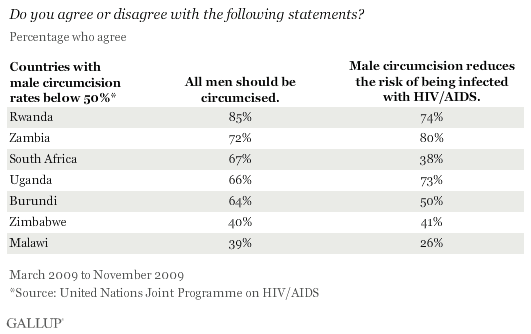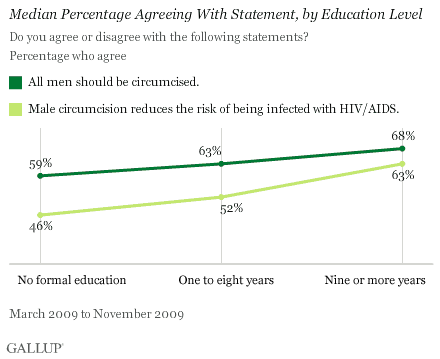WASHINGTON, D.C. -- Belief that all men should be circumcised and that male circumcision reduces the risk of being infected with HIV/AIDS is relatively high in several sub-Saharan African countries where 2009 circumcision rates were below 50%. A median of 66% among these populations say all men should be circumcised, but this belief varies from a high of 85% in Rwanda to a low of 39% in Malawi. A smaller median percentage, 50%, agrees that circumcision reduces the chance of getting infected with HIV/AIDS, but this belief, too, varies from a high of 80% in Zambia to a low of 26% in Malawi.

Sub-Saharan Africa is the region most affected by HIV, accounting for 67% of the world's HIV infections in 2008 and 72% of AIDS-connected deaths. Along with many strategies health professionals employ to stem the rate of HIV/AIDS, male circumcision has proven to reduce transmission among men. According to the United Nations Joint Programme on HIV/AIDS, the prevalence of male circumcision in the seven countries Gallup surveyed is low, ranging from 2% in Burundi to 35% in South Africa. That at least a sizable minority in every country surveyed recognizes that circumcision reduces the spread of HIV and believes that all men should be circumcised may be positive signs for ongoing efforts to prevent HIV infection.
Studies prior to 1996 did not find relationships between education levels and the risk of contracting HIV, but more recent analyses by James R. Hargreaves and others have noted a shift toward lower risk among those with more education. Gallup surveys in the seven countries also find the median percentage agreeing with each statement increases with education. Sixty-eight percent of respondents with at least nine years of formal education agree all men should be circumcised, compared with 59% of those with no formal education. Perhaps even more significantly, a median of 63% of the more educated group agree that circumcision reduces the chance of getting HIV/AIDS, versus 46% of those with no formal education.

Bottom Line
Although improved levels of education about HIV/AIDS do not necessarily change behaviors, the likelihood of change without education is low. Therefore, investment in effective education programs about circumcision should be increased and designed in such a way that those with lower levels of education hear and understand the message: circumcision reduces the chance of being infected with HIV.
For complete data sets or custom research from the more than 150 countries Gallup continually surveys, please contact SocialandEconomicAnalysis@gallup.com or call 202.715.3030.
Survey Methods
Results are based on face-to-face interviews with 1,000 adults, aged 15 and older, conducted between March and November 2009 in Burundi, Malawi, Rwanda, South Africa, Uganda, Zambia, and Zimbabwe. For results based on the total sample of national adults, one can say with 95% confidence that the maximum margin of sampling error ranged from a low of ±3.5 percentage points in Burundi to a high of ±4.1 percentage points in Zambia. The margin of error reflects the influence of data weighting. In addition to sampling error, question wording and practical difficulties in conducting surveys can introduce error or bias into the findings of public opinion polls.
